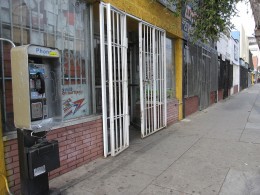The Forces of Gentrification

Marketplace has a big, long feature taking a look at how the neighborhood of Highland Park in Los Angeles is quickly gentrifying, and spent some time interviewing former and current residents, business owners, house flippers, and real estate brokers and investors to get a full picture of how the neighborhood is changing. The reporting is full of great details, but perhaps the most revealing is when we’re introduced to Nicole, a commercial real estate agent:
Nicole is a commercial real estate agent with Clint Lukens Realty and one of the many commercial agents who has marked Highland Park as her new territory in the last several months. She now spends considerable time in this neighborhood, staking out old buildings like the Swap Mall and old stores like Frank’s.
“This could be broken up into two or three cute boutiques,” she said, sizing up the Swap Mall building. “That’s probably going to happen soon.”
One of Nicole’s specialties is something called “retenanting.” Maybe you’ve never heard this word, but in commercial real estate it is a term of art, an actual job: find commercial buildings with low-rent tenants occupying storefronts, ideally on month-to-month leases, then “kick them out, retenant the property with new tenants at market rate,” Nicole explained.
Nicole admits this can sound predatory. “I do feel bad,” she said. “But it is a business. And when these people are paying under-market rents, and we have a client that owns the property, we have to look out for our client’s best interest.”
Gentrification often begins with artists moving into a neighborhood looking for cheap living options — and then it gets momentum due to the work of people like Nicole. We often ask whether gentrification is bad or good. Retenanting, it seems, is part of the bad aspects.
Support The Billfold
The Billfold continues to exist thanks to support from our readers. Help us continue to do our work by making a monthly pledge on Patreon or a one-time-only contribution through PayPal.
Comments